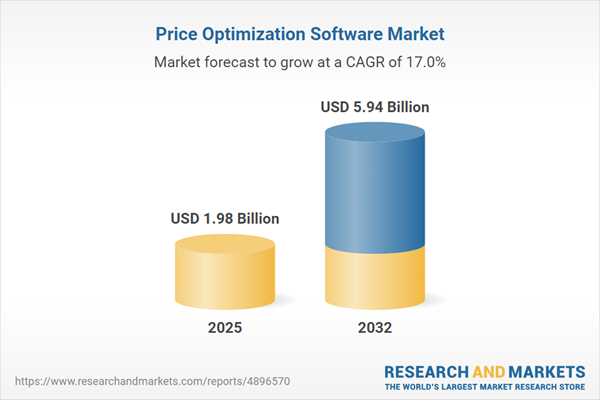Speak directly to the analyst to clarify any post sales queries you may have.
Price optimization software is gaining traction as a strategic asset for enterprises aiming to refine pricing strategies in rapidly evolving and competitive markets. As digital transformation continues to accelerate, senior decision-makers are prioritizing automated, data-driven pricing approaches to ensure both agility and profitability.
Market Snapshot: Growth of the Price Optimization Software Market
The global price optimization software market demonstrates robust momentum, driven by digital transformation initiatives and expanding analytics investments. As key sectors—including finance, retail, manufacturing, and healthcare—advance reliance on data-integrated pricing, technology such as artificial intelligence, automation, and real-time analytics underpins more effective and compliant pricing frameworks. Differences in adoption across geographies reflect regional digital maturity and regulatory landscapes. Many enterprises are replacing legacy manual pricing approaches with analytics-led solutions that fuel operational resilience and deliver long-term value creation as digital maturity progresses.
Scope & Segmentation of the Price Optimization Software Market
In-depth understanding of key product areas, deployment modes, enterprise sizes, and industry adoption informs executive decisions and procurement strategies. Exploring these market segments clarifies where and how price optimization software aligns with compliance pressures, digitalization trends, and variable operational contexts.
- Component: Pricing engines facilitate organization-wide standardization, while management services drive pricing automation and reduce manual effort for complex or geographically diverse operations.
- Deployment: Cloud, hybrid, and on-premises platforms accommodate diverse data security, compliance, and IT integration needs, offering flexible adaptation to evolving enterprise infrastructures.
- Organization Size: Large enterprises benefit from scale efficiency, while small and medium-sized businesses access advanced pricing technology for accelerated transformation and responsiveness across their settings.
- End User Industry: Sectors such as banking, financial services, e-commerce, retail, manufacturing, healthcare, travel, and hospitality require robust pricing optimization to meet regulatory scrutiny, drive efficiency, and strengthen customer relationships.
- Pricing Model: Subscription and perpetual license models empower organizations to align spending with budget cycles and long-term investment horizons, supporting predictable and sustainable operational planning.
- Region: North America, Europe, Middle East & Africa, and Asia-Pacific each reflect unique regulatory requirements and digital infrastructure standards that guide adoption and customization.
- Company Coverage: Leading enterprise-focused vendors—including PROS Holdings, Vendavo, SAP, Oracle, Zilliant, Pricefx, Vistaar Technologies, Revionics, Wiser Solutions, and Antuit.ai—offer adaptable solutions tailored to diverse organizational needs.
Key Takeaways for Senior Decision-Makers
- Price optimization automation reduces reliance on traditional, manual processes and enables organizations to address shifts in market dynamics effectively.
- Centralized pricing platforms support collaboration across finance, sales, and operations, improving governance and aligning objectives for greater consistency in business performance.
- Real-time analytics and machine learning accelerate actionable insights, enabling faster, more profitable responses to evolving business needs and market trends.
- Artificial intelligence enhances transparency and traceability, simplifying regulatory compliance for senior executives and ensuring enterprise risk management objectives are met.
- Scenario planning capabilities allow organizations to anticipate and model for changing regulatory climates and emerging market challenges, building operational resilience.
- Strategic partnerships with experienced vendors streamline complex technology rollouts and help multinational enterprises address local regulatory standards.
Tariff Impact: Navigating Price Optimization Amid Global Cost Shifts
Tariff volatility is driving cost sensitivity, particularly for enterprises with extensive on-premises systems. Many now pivot to cloud or hybrid price optimization platforms, improving control over operating expenses and meeting rising efficiency requirements. Leveraging predictive analytics and enhanced supplier management enables senior leaders to stabilize business operations and sustain agility despite economic headwinds.
Methodology & Data Sources
This market analysis combines primary research from senior executive interviews with comprehensive secondary sources. Multivariate regression and scenario-based forecasting methodologies deliver actionable recommendations tailored to current and future pricing complexities.
Why This Report Matters
- Offers practical guidance for embedding price optimization software within core enterprise risk and compliance frameworks, improving operational discipline and ensuring regulatory standards are met.
- Enables simulation-based benchmarking for organizations looking to maximize the value and operational impact of pricing initiatives.
- Empowers procurement teams to align technology investments with evolving business environments and complex compliance landscapes.
Conclusion
Price optimization software equips executive teams to advance strategic pricing, drive process innovation, and reinforce resilience. Proactive investment in these solutions positions organizations for sustainable competitive advantage, regardless of market volatility.
Additional Product Information:
- Purchase of this report includes 1 year online access with quarterly updates.
- This report can be updated on request. Please contact our Customer Experience team using the Ask a Question widget on our website.
Table of Contents
3. Executive Summary
4. Market Overview
7. Cumulative Impact of Artificial Intelligence 2025
Companies Mentioned
The companies profiled in this Price Optimization Software market report include:- PROS Holdings, Inc.
- Vendavo, Inc.
- SAP SE
- Oracle Corporation
- Zilliant, Inc.
- Pricefx GmbH
- Vistaar Technologies, Inc.
- Revionics, Inc.
- Wiser Solutions, Inc.
- Antuit.ai, Inc.
Table Information
| Report Attribute | Details |
|---|---|
| No. of Pages | 197 |
| Published | October 2025 |
| Forecast Period | 2025 - 2032 |
| Estimated Market Value ( USD | $ 1.98 Billion |
| Forecasted Market Value ( USD | $ 5.94 Billion |
| Compound Annual Growth Rate | 17.0% |
| Regions Covered | Global |
| No. of Companies Mentioned | 11 |









